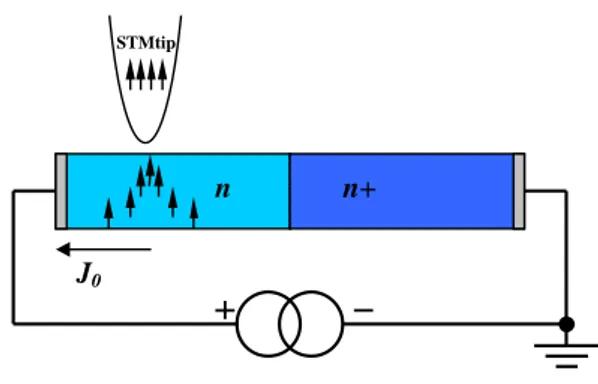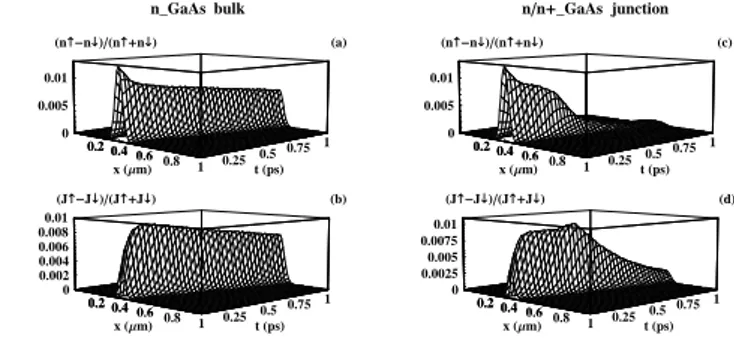Brazilian Journal of Physics, vol. 36, no. 3B, September, 2006 851
Transient Spin Dynamics in Semiconductors
L. Villegas-Lelovsky
Departamento de F´ısica e Inform´atica, Instituto de F´ısica de S˜ao Carlos, Universidade de S˜ao Paulo, 13560-970 S˜ao Carlos, S˜ao Paulo, Brazil
Received on 8 December, 2005
We investigate the spin-resolved dynamics of spin-polarized carriers injected via a ferromagnetic scanning-tunnelling-microscope tip (STM tip) into uniformly and non-uniformly n-doped bulk semiconductor – externally driven by a current source. We propagate the injected spin packets (assumed gaussian in space att=0) by considering a spin hydrodynamic approach based on balance equations directly derived from a spin-dependent Boltzmann equation. We determine the spin-polarization landscapes (time and position) of the carrier population (n↑−n↓)/(n↑+n↓)and the current density (j↑−j↓)/(j↑+j↓). While in the uniformly-doped system the carrier spin-polarization has a slow decay, in the non-uniformly doped system it shows a drastic fall down in the interface. In contrast the current spin-polarization exhibits an enhancement for both of the systems particularly in the interface.
Keywords: Spin polarized transport; Semiconductors; Interfaces; Electrical injection
I. INTRODUCTION
The dynamics of photogenerated carriers in semiconduc-tors and their heterostructures is a mature subject. A variety of interesting time-dependent phenomena have been investi-gated over the past decade or so: coupled plasmon-phonon dynamics, coherent phonon oscillations, terahertz emission from bulk systems pumped with ultrashort laser pulses, etc. Strictly speaking, the complex carrier dynamics of a semi-conductor system following pump excitation should require a full-blow non-equilibrium calculation (e.g., via the Keldysh formalism) – particularly if one is interested in the quantum-coherent effects of the transient dynamics of electrons, holes, and phonons. Other approaches in terms of the semiclassical Boltzmann equation can provide a suitable description for dif-fusive transport dynamics. A hydrodynamic approach based on the moments of the Boltzmann equation – i.e., the continu-ity equations for the particle and the current densities – is yet another possibility. Recently, this simpler approach has been used to successfully describe the terahertz carrier-phonon dy-namics and the corresponding electromagnetic emission from bulk semiconductors [1].
Motivated by the recent realization of ferromagnetic STM tip injection [2], we investigate in this work the transient dy-namics of spin-polarized electron packets STM-tip injected into a n−doped GaAs semiconductor, Fig. 1. We solve the particle- and current-density continuity equations – equa-tions involving the first and the second moments of the spin-resolved Boltzmann equation – coupled to Poisson’s equa-tion describing the internal electric field profile. Spin-flip and momentum-relaxation processes are taken into account within the average relaxation-time approximation [3]. Our spin-resolved hydrodynamic description goes beyond the usual drift-diffusion type approaches [4], [5], [6], [7] in that we fully account for the temporal evolution of the current densities. For STM tip injection into a uniformly dopedn-GaAs system and into an/n+GaAs junction driven by a current source, we find the spin-polarization landscapes for carrier and current densities.
n
J0
STMtip
n+
FIG. 1: Schematic of the ferromagnetic STM-tip spin injection into a inhomogeneousn/n+GaAs, externally driven by a current source
J0. We also consider injection into uniformlyn-doped bulk GaAs (not shown). The injection profile is assumed gaussian in space at
δt≤0.1ps. By numerically propagating our continuity equations, we determine the spin-resolved carrier and current densities and the corresponding spin-polarization landscapes [Figs. 2(a)-(d)].
II. SPIN HYDRODYNAMIC EQUATIONS
The starting point of our approach is the spin-dependent Boltzmann equation governing the evolution of the semiclas-sical distribution function fσ(r,k,t)of the carriers with spin componentσ=↑,↓ ( ¯σ=↓,↑) in a bulk semiconductor. The number of the carriers with spin componentσ in a volume drdkabout the phase-space point (r,k) is fσ(r,k,t)d3rd3k.
852 L. Villegas-Lelovsky
coupled moments thus obtaining the finite set of equations
∂nσ ∂t +
∂Jσ ∂x =G
σ−nσ−nσ¯
τs f , (1)
∂Jσ ∂t +
∂ ∂x
µJ nJ
σ¶=
qE m∗ e
nσ−kBT m∗ e
∂ ∂xn
σ−Jσ
τσ−
Jσ−Jσ¯ τ∗
s f
. (2)
whereq=−eis the electron charge and m∗e is the electron effective mass, which describes the evolution of our system. The three distinct average relaxation times in Eqs. (1) and (2) denote (i) the spin-dependent momentum relaxation timeτσ, (ii) the intrinsic carrier spin-flip timeτs f describing the equi-libration of the spin populations, and (iii) the current-density spin-flip time τ∗
s f representing the tendency of equalization of the two spin-channel current densities through momentum scattering with spin flip [10]. The total carrier and current den-sities aren=nσ+nσ¯ andJ=Jσ+Jσ¯. We have added a gen-eration termGσ(x,t)(gaussian in space and a delta function in time) to the continuity equation (1), representing the injec-tion of spin-oriented carriers (e.g., via ferromagnetic STM tip or optical generation with circularly polarized light). In the case of non-magnetic semiconductorsτσ→τand we recover the spinless continuity equations of Ref.[1] by adding the two spin resolved components in Eq. (1).
III. POISSON’S EQUATION
The internal electric fieldE(x,t)is calculated via,
∂E(x,t) ∂x =
q ε0ε∞[
nσ(x,t) +nσ¯(x,t)−nd(x)] (3)
whereε0is the vacuum permeability constant, ε∞ is the
di-electric constant,nd(x)is ionized donor concentration.
IV. NUMERICAL CALCULATION
We develop numerical calculations via finite-differences discretization. By propagating the resulting discretized equa-tions in time and space via explicit schemes (Lax method) [11], we calculate the carrier- and current-density profiles and from these we determine the corresponding spin-polarization landscapes, Figs. 2(a)-(d). In our simulations we usend(x) = 1017cm−3(0≤x≤1µm) (n GaAs bulk case) and nd(x) = 1017cm−3(0µm≤x≤0.5µm),5×017cm−3(0.5µm<x≤1µm)
(n/n+ GaAs junction case) Te =300 K, an external elec-tric fieldE0=−10 kV/cm,τ=100 fs [12],τs f =4 ps [13], τ∗
s f≫τs f [14]). The 1D study is performed by assuming that the important features of the charge transport in the system are given in the electric field direction.
n_GaAs bulk nn+_GaAs junction
HJ-J¯LHJ+J¯L HbL
0.2 0.4 0.6 0.8 1
xHΜmL 0.25
0.5 0.75 1 tHpsL 0 0.002 0.004 0.006 0.008 0.01 0.2 0.4 0.6 0.8
HJ-J¯LHJ+J¯L HdL
0.2 0.4 0.6 0.8 1
xHΜmL 0.25
0.5 0.75 1 tHpsL 0 0.0025 0.005 0.0075 0.01 0.2 0.4 0.6 0.8
Hn-n¯LHn+n¯L HaL
0.2 0.40.6 0.8 1
xHΜmL 0.25
0.5 0.75 1 tHpsL 0
0.005 0.01
0.2 0.40.6 0.8
Hn-n¯LHn+n¯L HcL
0.2 0.40.6 0.8 1
xHΜmL 0.25
0.5 0.75 1 tHpsL 0
0.005 0.01
0.2 0.40.6 0.8
FIG. 2: Spin-polarization landscapes of the carrier and current den-sities for homogeneous (a) and inhomogenous (b) doped GaAs af-ter propagating a Gaussian-like spin-up polarized pulse of elec-trons injected inx0=0.4µm by a fm-STM tip. While the carrier polarization (Fig. 2(c)) is lost at interface the current spin-polarization is enhanced( Fig. 2(d)) through the regions of different doping levels.
V. RESULTS AND DISCUSSIONS
If we consider a certain distribution of charge concentra-tion (all the donors are ionized withn↑0=nd(x)/2 andn↓0=
nd(x)/2) and a constant applied electric field as initial con-ditions, we obtain after solving a system of five differential equations Eqs. (1) withGσ=0, (2) and (3) fort≫τthat the total density current as well as the electric field profile throughout the semiconductor reach a stationary configura-tion, i.e. J(x,t) =J0 andE(x,t) =E(x). After injecting a
spin-Brazilian Journal of Physics, vol. 36, no. 3B, September, 2006 853
carriers from doping than those in the n region. Instead of this we found that the current spin polarization shows an en-hancement in the interface due to a constant total background current Fig. 2d.
VI. SUMMARY AND CONCLUSIONS
We studied the transient dynamics of spin-polarized elec-tron packets STM-tip injected into homogeneous and inhomo-geneousn-doped GaAs systems. Our approach shows prop-erly in the regime of the ultra-fast phenomena the transient behavior of the spin-polarization for carrier and current den-sities. In the case of the n/n+GaAs system it was proved despite the spin-electron polarized packet is amplified at
inter-face it has not consequences over the carrier spin- polarization landscape. Instead of this we found that the carrier spin- po-larization has a drastic fall off within then/n+GaAs junction compared with the homogeneousn- GaAs system due to the spin carrier background. Furthermore an enhancement in the current spin-polarization case was observed for both systems following the dynamics of the spin current densities since that the spin current background has not influence in this case.
Acknowledgments
I gratefully acknowledge helpful discussions with J. C. Egues and F. M. Souza.This work was supported by the CLAF/CNPq.
[1] F. M. Souza and J. C. Egues, Phys. Rev. B 66, 060301(R) (2002).
[2] V. P. Labellaet al., Science292, 1518 (2001).
[3] Note that the relaxation time approximantion here is performed at level of the balance equations. See S. Datta, Quantum Phe-nomena v. 8, Addison-Wesley 1989.
[4] D. T. Pierceet al., Rev. Sci. Instrum.51, 478 (1980). [5] T. Sogawa,et al., Phys. Rev. B61, 5535 (2000).
[6] I. ˇZuti´cet al., Phys. Rev. B64, 121201 (2001); Phys. Rev. Lett.
88, 066603 (2002).
[7] Z. G. Yu and M. E. Flatt´e, Phys. Rev. B66, 235302 (2002). [8] U. Ravaioli, Semicond. Sci. Technol.13, 1 (1998).
[9] In the Boltzmann transport equation we have considered the Fermi surface under an electric field in thex-direction therefore we integrate the distribution function of particles in the momen-tum space to obtain for instance the charge density at(r,t)that is uniform in a vicinityd3r. The dynamics of the electrical par-ticles described by the physical magnitude j is leaded by the change of the electrical field in the preferentialx-direction. In case ofn(x,t)we are assumed that the charge density is constant
in the remainingyandzdirections.
[10] This parameter after microscopic treatment appear in the prob-lem of the two current conduction in ferromagnetic metals (A. Fert, J. Phys. C 2(2), 1784 (1969)).
[11] See, W. H. Press, S. A. Teukolsky, W. T. Vetterling and B. P. Flannery, Numerical Recipes in C, the Art of Scientific
Com-puting, (Cambridge University, London, 1996) 2nd edition Ch.
19.
[12] M.T. Portellaet al., Appl. Phys. Lett.60, 2123 (1992). [13] Spin lifetime at 300Kfor GaAs is up to 100ps. However spin
relaxation lifetimes are expected to be shorter for high kinetic energy electrons (E=−10KV/cm).
[14] We found thatτ∗
s f ≫τs f can be holded due to extra transport
contributions. Here we assume an infinity value forτ∗
s f since
that it does not modify the results from the qualitative point of view. The influence of this parameter will be matter of discus-sion in the another full paper.

